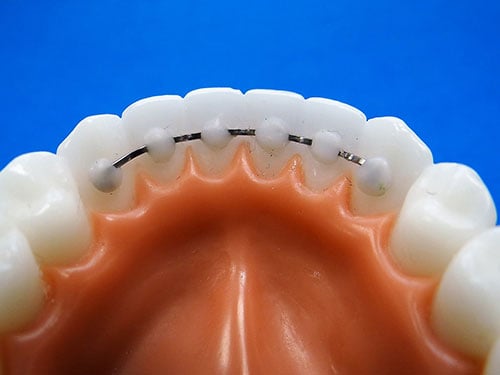Discover the key differences between bonded retainers and Essix retainers and learn why bonded retainers are a popular choice among orthodontic patients.
What are bonded retainers?
Bonded retainers, also known as permanent retainers, are a type of orthodontic appliance that is bonded to the back of the teeth. They are made of a thin wire that is custom-fitted to the patient's teeth and secured in place using dental cement.
These retainers are typically used after the completion of orthodontic treatment, such as braces or aligners, to maintain the new position of the teeth. Unlike removable retainers, bonded retainers are fixed in place and cannot be removed by the patient.
One of the main advantages of bonded retainers is that they provide continuous support to the teeth, preventing them from shifting back to their original positions. This makes them a popular choice among orthodontic patients who want to ensure long-term stability of their teeth.
However, it's important to note that bonded retainers require extra care and maintenance. They can accumulate plaque and tartar more easily than removable retainers, so proper oral hygiene is crucial to prevent dental issues.
Overall, bonded retainers are a reliable option for maintaining the results of orthodontic treatment and ensuring the teeth remain in their desired position.
Advantages of bonded retainers
There are several advantages to choosing bonded retainers:
1. Continuous support: Bonded retainers provide constant support to the teeth, preventing them from shifting back to their original positions.
2. Convenience: Unlike removable retainers, bonded retainers are fixed in place and do not require daily removal or adjustment.
3. Invisible: Bonded retainers are placed on the back of the teeth, making them virtually invisible to others.
4. Long-term stability: Bonded retainers are designed to be long-lasting, ensuring the teeth remain in their desired position for years to come.
However, it's important to note that bonded retainers may not be suitable for everyone. Your orthodontist will assess your individual case and determine the best retainer option for you.
Disadvantages of bonded retainers
While bonded retainers offer many benefits, they also have some disadvantages to consider:
1. Maintenance: Bonded retainers require extra care and maintenance to keep them clean and free from plaque and tartar.
2. Limited adjustability: Unlike removable retainers, bonded retainers cannot be adjusted or modified once they are bonded to the teeth.
3. Potential for damage: Bonded retainers can be more prone to breakage compared to removable retainers, especially if they are subjected to excessive force or trauma.
4. Difficulty in flossing: Due to their fixed nature, it can be challenging to floss between the teeth with bonded retainers. Special flossing techniques or tools may be required.
It's important to discuss these potential drawbacks with your orthodontist to determine if bonded retainers are the right choice for you.
Bonded retainers vs. Essix retainers
Bonded retainers and Essix retainers are two common options for orthodontic patients, each with its own advantages and considerations:
1. Retention: Bonded retainers provide continuous support and retention, while Essix retainers are removable and need to be worn consistently to maintain the results of orthodontic treatment.
2. Visibility: Bonded retainers are placed on the back of the teeth, making them virtually invisible. Essix retainers, on the other hand, are clear and more noticeable when worn.
3. Maintenance: Bonded retainers require extra care and attention to keep them clean, while Essix retainers can be easily cleaned by brushing and soaking.
4. Adjustability: Essix retainers can be adjusted or modified if necessary, while bonded retainers cannot be adjusted once they are bonded to the teeth.
Ultimately, the choice between bonded retainers and Essix retainers depends on the individual's preferences, lifestyle, and the recommendation of their orthodontist.
How to care for bonded retainers
To ensure the longevity and effectiveness of your bonded retainers, it's important to follow these care tips:
1. Maintain good oral hygiene: Brush your teeth thoroughly at least twice a day and floss regularly. Pay extra attention to cleaning around the bonded retainers to prevent plaque buildup.
2. Avoid hard or sticky foods: Minimize the consumption of hard or sticky foods that can put excessive pressure on the bonded retainers and increase the risk of breakage.
3. Regular dental check-ups: Visit your dentist or orthodontist regularly for check-ups and professional cleaning to ensure the health of your teeth and retainers.
4. Seek professional help for issues: If you experience any discomfort, breakage, or loosening of your bonded retainers, contact your orthodontist immediately for professional assistance.
By following these care guidelines, you can maintain the integrity of your bonded retainers and enjoy the long-term benefits they provide.


